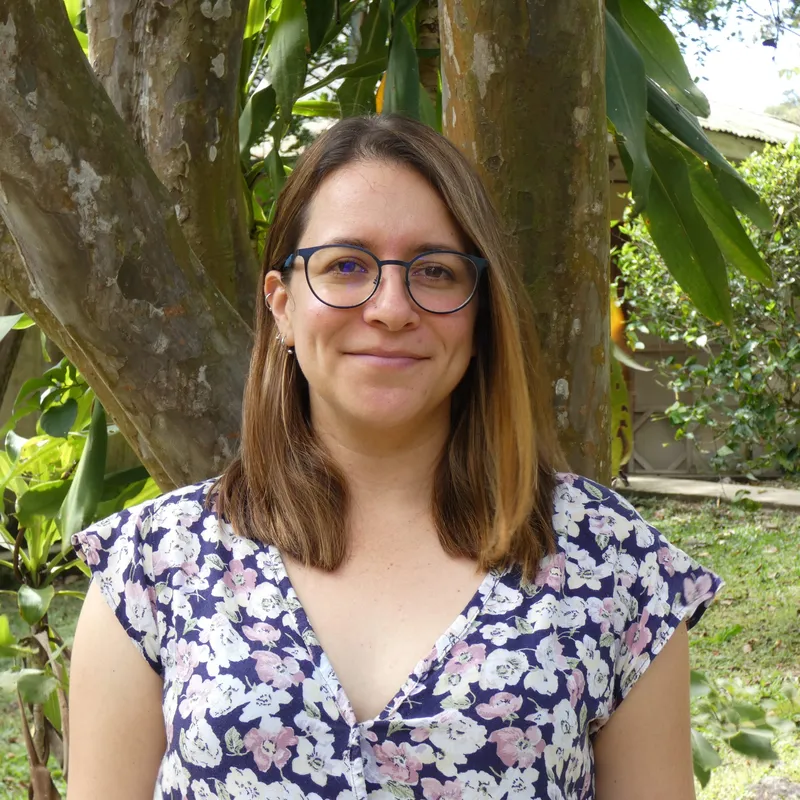Milena Cambronero, M.S.

Milena Cambronero, M.S.
Title
Education
Teaching
about
Faculty Profile
Milena Cambronero was born and raised in San Ramón, Alajuela (Costa Rica), where she grew up surrounded by coffee plantations. Milena holds a BSc. and a MSc. degree in Biology from the University of Costa Rica (UCR), and a BSc. in Anthropology, also from UCR. Since 2017, she has been teaching undergraduate courses in Tropical Ecology, Conservation Science and Natural Resource Management. Milena studied the allometry and carbon accumulation in palms of the Caribbean slope of Costa Rica. She is currently focusing on community-based natural resource management and ecosystem services related to water protection.
Areas of Expertise
- Community-based natural resource management
- Mammal ecology and conservation
- Carbon sequestration
Academics & Research
Research Interests
I am interested in the connection between water source protection and other ecosystem services such as carbon sequestration and biodiversity conservation. I am especially interested in studying forest fragments managed by local associations to supply potable water to local communities. Currently, I am co-coordinating a project that explores the relationship between water protection and the conservation of medium and large-sized mammals. I am convinced that successful conservation strategies require active participation from multiple stakeholders, from community-based associations to international institutions. Therefore, we are partnering with a local association which focuses on environmental conservation and with the National System of Conservation Areas of Costa Rica. I am also interested in environmental education. I consider that communicating scientific information to the general public is essential for engaging people in conservation of biodiversity and ensuring the future of ecosystem services.
Research Projects
Communal aqueducts as potential mammal conservation units in Atenas (Costa Rica)
There are about 1400 local associations in Costa Rica, which provide water to approximately 1.3 million people. These associations manage forest fragments that, in addition of protecting water sources, also serve as a refuge for endangered species, such as medium and large-sized mammals, that are globally threatened due to habitat loss and fragmentation. The purpose of this project is to conduct an environmental assessment of the water protection areas managed by communal aqueducts in the county of Atenas (Alajuela, Costa Rica). We are currently evaluating land use in water protection areas managed by five associations and are assessing medium and large-sized mammals in these fragments using camera traps.
Social and biophysical assessment of the Quebrada Matías Watershed (Atenas, Costa Rica)
Quebrada Matías (QM) is a 4 km stream, tributary of the Río Grande de Tárcoles, the most polluted river in Costa Rica. There are six communities (approximately, 1000 people) inhabiting this basin. In 2012 SFS students gathered basic information as part of a local initiative to recover the QM. We developed a social and biophysical reassessment of this stream in 2019, with the objectives of analyzing the relationship between urban expansion and vegetation cover along the QM between 2012 and 2019, assessing the water quality of the QM by using macroinvertebrates as bioindicators, and proposing an action plan to recover the stream. We found that canopy cover along the stream decreased from 78.62% (0.11 km²) in 2012 to 69.67% (0.10 km²) in 2019, and deforestation was present in areas close to roads and urban areas. Water quality of the QM was classified as polluted, very polluted and extremely polluted. Pollution was associated to cattle and gray water. Students proposed an action plan to recover the stream based on six principles: regulating constructions, reforestation, control water pollution, cattle, maintenance and education. The information gathered during this project, was shared with local stakeholders in 2019 and 2022.
outputs
Publications
Cambronero, M., Avalos, G., & Alvarez-Vergnani, C. (2018). Carbon fraction in the tissues of seven neotropical palm species from different forest strata. Palms, 62(1), 25-34.
Avalos, G., Gei, M. G., Ríos, L. D., Fernández, M., Cambronero, M., Alvarez-Vergnani, C., Sylvester, O., & Rojas, G. (2018). Analysis of the stem diameter versus height allometry of 13 neotropical palm species of different forest strata. In press.
Ávalos, G., Cambronero, M., & Vargas, O. 2016. Quantification of browsing damage to the stilt root cone of Socratea exorrhiza (Arecaceae) by Collared Peccaries (Pecari tajacu, Artiodactyla: Tayassuidae) at La Selva, Costa Rica. Brenesia, 85-86.